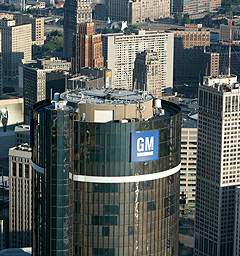Make / Model Search
News - General MotorsGM to flood market with sharesGoing down: Shares in General Motors will become confetti under new ownership arrangements. Current shareholders to end up with just one per cent of new-look GM6 May 2009 By IAN PORTER GENERAL Motors shares will be basically worthless when it swaps its mountain of debt for new scrip as part of president Barack Obama’s car industry bail-out. Shareholders who hold 100 per cent of GM in 611 million shares will see their holding reduced to barely one per cent of the company after GM swamps the market with around 61 billion new shares to redeem $US44 billion ($A59.4 billion) of debt. The value of existing shares will plummet from an already-depressed $US1.85 ($A2.50) to around one cent, completing a sad decline for GM shares that were once the bedrock investment of pension funds and family portfolios. GM has offered all its debtors just 225 shares for every $US1000 ($A1349) of debt principal they are owed. That places a notional value of $US4.44 on every share issued, but that value is more than 400 times what the new shares will be worth. The US treasury, which is guiding GM through its restructuring, having lent GM $US20 billion to tide it over this reconstruction period, will take new shares for $US10 billion of its debt. The union-led Voluntary Employee Benefit Association (VEBA) will also take new shares for half of the $US20 billion GM has agreed to pay in full and final settlement of all health fund liabilities owed to former employees.  The biggest swag of shares will go to GM’s bondholders, who are owed a total of $US27 billion on their unsecured notes and debentures. The biggest swag of shares will go to GM’s bondholders, who are owed a total of $US27 billion on their unsecured notes and debentures.But they will also be the biggest losers as the treasury department has singled them out for special attention, perhaps because they triggered the potential bankruptcy of GM when they did not accept an earlier debt swap offer from GM. Although bondholders are owed more than the treasury and the VEBA, treasury has stipulated that the bondholders are to own no more than 10 per cent of GM’s expanded capital. In contrast, the VEBA will own 40 per cent and the treasury 49 per cent after they convert their debt. If the debt-swap is successful, GM plans to consolidate all the shares on issue on a 100-into-one basis, which will reduce then issued capital from around 62 billion to 620 million shares, about what the issued capital is now. The bondholders are complaining about the different values placed on their debt and that owed to the treasury and the VEBA. They claim their payout is unfairly low and are claiming that they should control GM after the debt swap is over. The bondholders have to accept the debt-swap offer for at least $US24 billion of the $US27 billion they are owed for the whole process to succeed. In a statement made yesterday to the New York Stock Exchange, the company repeated its threat to enter bankruptcy if the debt-swap offer fell short. “In the event that GM does not receive prior to June 1, 2009, enough tenders of notes to consummate the exchange offers, GM currently intends to seek relief under the US Bankruptcy Code. “If GM seeks bankruptcy relief, note-holders may receive consideration that is less than what is being offered in the exchange offers and it is possible that such holders may receive no consideration at all for their notes,” the statement read. There are several conditions riding on the debt-swap offer. The US treasury will not participate if less than 90 per cent of GM’s $US27 billion in unsecured bonds are offered by noteholders. From GM’s side, it is conditional on both the Treasury and the VEBA accepting for at least 50 per cent of the amounts they are owed. Another GM condition is that the US Treasury will commit to advancing a further $US11.6 billion in loans to GM after May 1, when its current liquid resources are expected to be exhausted. Read more:GM break-up acceleratesGM slashes factories, jobs, dealers GM increases pressure on debtors, union |
Click to shareGeneral Motors articlesMotor industry news |









Facebook Twitter Instagram